tyre FIAT MULTIPLA 2007 1.G Owners Manual
[x] Cancel search | Manufacturer: FIAT, Model Year: 2007, Model line: MULTIPLA, Model: FIAT MULTIPLA 2007 1.GPages: 266, PDF Size: 4.66 MB
Page 91 of 266
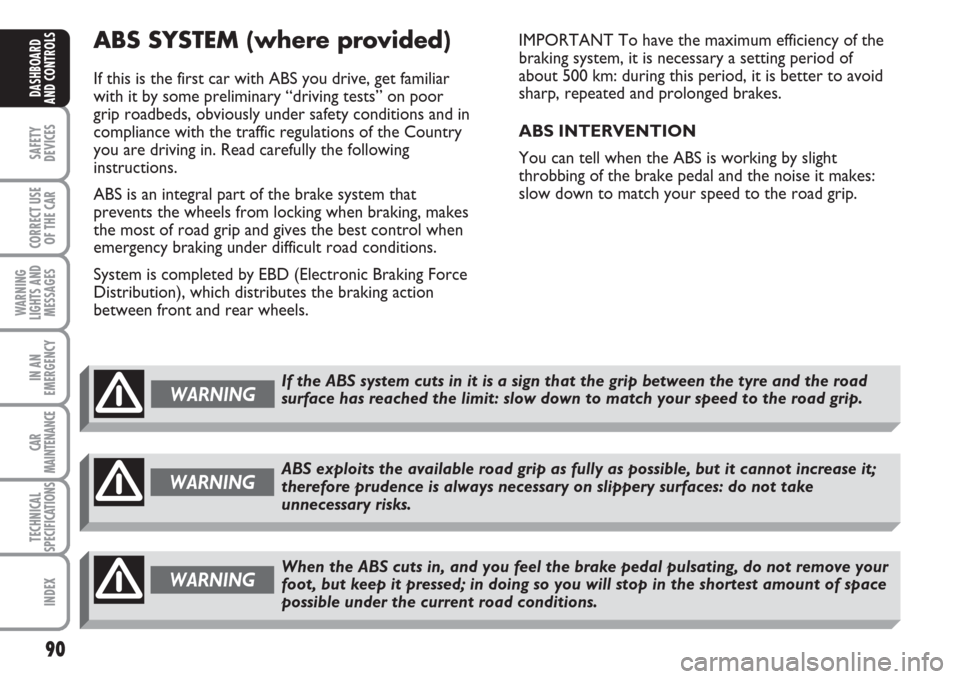
90
SAFETY
DEVICES
CORRECT USE
OF THE CAR
WARNING
LIGHTS AND
MESSAGES
IN AN
EMERGENCY
CAR
MAINTENANCE
TECHNICAL
SPECIFICATIONS
INDEX
DASHBOARD
AND CONTROLS
ABS SYSTEM (where provided)
If this is the first car with ABS you drive, get familiar
with it by some preliminary “driving tests” on poor
grip roadbeds, obviously under safety conditions and in
compliance with the traffic regulations of the Country
you are driving in. Read carefully the following
instructions.
ABS is an integral part of the brake system that
prevents the wheels from locking when braking, makes
the most of road grip and gives the best control when
emergency braking under difficult road conditions.
System is completed by EBD (Electronic Braking Force
Distribution), which distributes the braking action
between front and rear wheels.IMPORTANT To have the maximum efficiency of the
braking system, it is necessary a setting period of
about 500 km: during this period, it is better to avoid
sharp, repeated and prolonged brakes.
ABS INTERVENTION
You can tell when the ABS is working by slight
throbbing of the brake pedal and the noise it makes:
slow down to match your speed to the road grip.
ABS exploits the available road grip as fully as possible, but it cannot increase it;
therefore prudence is always necessary on slippery surfaces: do not take
unnecessary risks.WARNING
When the ABS cuts in, and you feel the brake pedal pulsating, do not remove your
foot, but keep it pressed; in doing so you will stop in the shortest amount of space
possible under the current road conditions. WARNING
If the ABS system cuts in it is a sign that the grip between the tyre and the road
surface has reached the limit: slow down to match your speed to the road grip.WARNING
Page 93 of 266
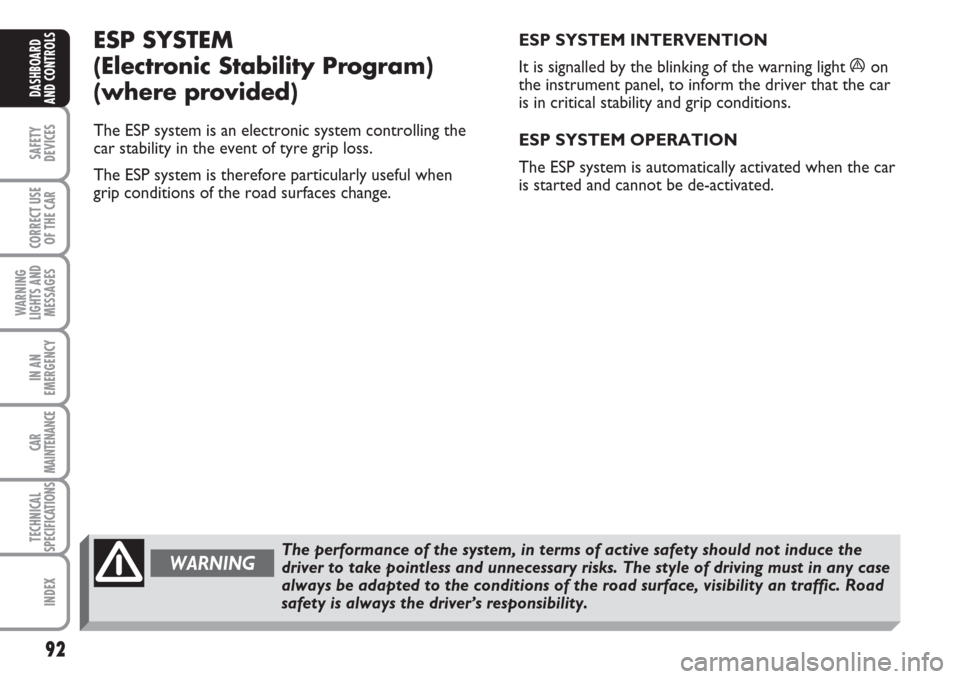
92
SAFETY
DEVICES
CORRECT USE
OF THE CAR
WARNING
LIGHTS AND
MESSAGES
IN AN
EMERGENCY
CAR
MAINTENANCE
TECHNICAL
SPECIFICATIONS
INDEX
DASHBOARD
AND CONTROLS
ESP SYSTEM
(Electronic Stability Program)
(where provided)
The ESP system is an electronic system controlling the
car stability in the event of tyre grip loss.
The ESP system is therefore particularly useful when
grip conditions of the road surfaces change.ESP SYSTEM INTERVENTION
It is signalled by the blinking of the warning light
áon
the instrument panel, to inform the driver that the car
is in critical stability and grip conditions.
ESP SYSTEM OPERATION
The ESP system is automatically activated when the car
is started and cannot be de-activated.
WARNINGThe performance of the system, in terms of active safety should not induce the
driver to take pointless and unnecessary risks. The style of driving must in any case
always be adapted to the conditions of the road surface, visibility an traffic. Road
safety is always the driver’s responsibility.
Page 94 of 266

93
SAFETY
DEVICES
CORRECT USE
OF THE CAR
WARNING
LIGHTS AND
MESSAGES
IN AN
EMERGENCY
CAR
MAINTENANCE
TECHNICAL
SPECIFICATIONS
INDEX
DASHBOARD
AND CONTROLS
F0E0384m
FAILURE WARNINGS
In the event of failure, the ESP system is automatically disconnected and
the instrument panel warning light (A) comes on together with the
message on the display (see section “Warning lights and messages”).
In this case, go to a Fiat Dealership as soon as possible.
WARNINGDuring the use of the space-saver spare wheel, the ESP system carries on working.
However, you must remind that the space-saver spare wheel presents dimensions
smaller than the standard tyre and therefore its grip is reduced as to the other car
tyres.
For correct operation of the ESP system, the tyres must absolutely be of the same
brand and type on all wheels, in perfect conditions and, above all, of type, brand
and size specified.WARNING
Page 96 of 266
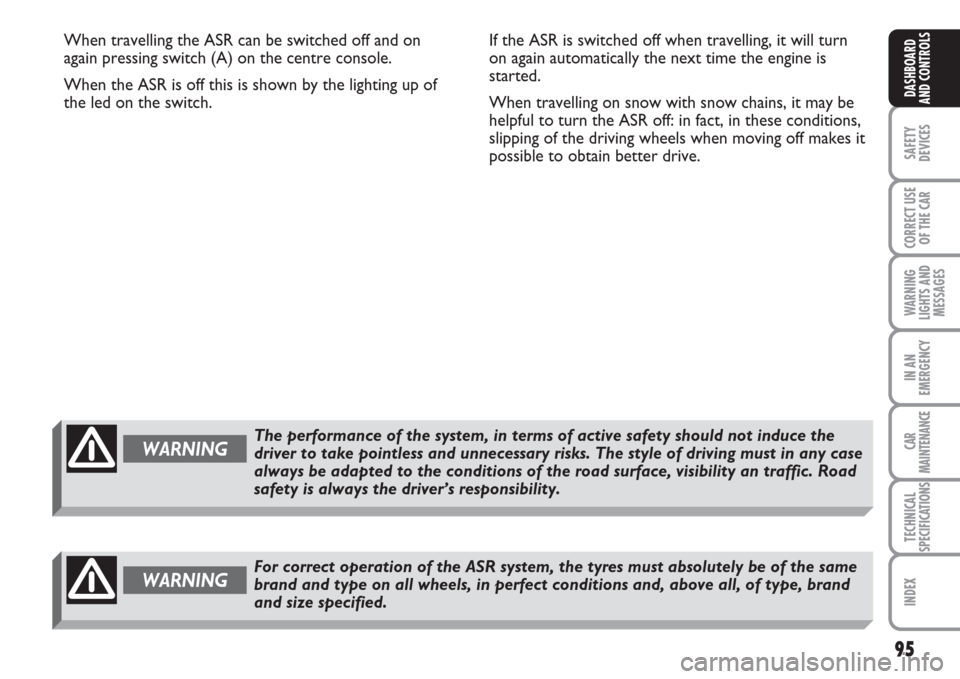
95
SAFETY
DEVICES
CORRECT USE
OF THE CAR
WARNING
LIGHTS AND
MESSAGES
IN AN
EMERGENCY
CAR
MAINTENANCE
TECHNICAL
SPECIFICATIONS
INDEX
DASHBOARD
AND CONTROLS
When travelling the ASR can be switched off and on
again pressing switch (A) on the centre console.
When the ASR is off this is shown by the lighting up of
the led on the switch.If the ASR is switched off when travelling, it will turn
on again automatically the next time the engine is
started.
When travelling on snow with snow chains, it may be
helpful to turn the ASR off: in fact, in these conditions,
slipping of the driving wheels when moving off makes it
possible to obtain better drive.
WARNINGThe performance of the system, in terms of active safety should not induce the
driver to take pointless and unnecessary risks. The style of driving must in any case
always be adapted to the conditions of the road surface, visibility an traffic. Road
safety is always the driver’s responsibility.
For correct operation of the ASR system, the tyres must absolutely be of the same
brand and type on all wheels, in perfect conditions and, above all, of type, brand
and size specified. WARNING
Page 137 of 266

136
WARNING
LIGHTS AND
MESSAGES
IN AN
EMERGENCY
CAR
MAINTENANCE
TECHNICAL
SPECIFICATIONS
INDEX
DASHBOARD
AND CONTROLS
SAFETY
DEVICES
CORRECT USE
OF THE CAR
CC C
O O
R R
R R
E E
C C
T T
U U
S S
E E
O O
F F
T T
H H
E E
C C
A A
R R
ENGINE STARTING ........................................................... 137
PARKING .............................................................................. 140
USING THE MANUAL GEARBOX ................................ 142
CONTAINING RUNNING COSTS ............................... 143
TOWING TRAILERS .......................................................... 145
SNOW TYRES ...................................................................... 149
SNOW CHAINS .................................................................. 150
STORING THE CAR .......................................................... 151
Page 144 of 266

143
WARNING
LIGHTS AND
MESSAGES
IN AN
EMERGENCY
CAR
MAINTENANCE
TECHNICAL
SPECIFICATIONS
INDEX
DASHBOARD
AND CONTROLS
SAFETY
DEVICES
CORRECT USE
OF THE CAR
CONTAINING RUNNING COSTS
Here are some suggestions which may help you to
keep the running costs of your car down and lower
the amount of toxic emissions released into the
atmosphere.
GENERAL CONSIDERATIONS
Car maintenance
Have checks and adjustments carried out in
accordance with the “Service schedule”.
Tyres
Check the pressure of the tyres routinely at an
interval of no more than 4 weeks: if the pressure is
too low, consumption levels increase as resistance to
rolling is higher.
Unnecessary loads
Do not travel with too much luggage stowed in the
boot. The weight of the car (especially when driving in
town) and its trim greatly affects consumption and
stability.Roof rack/ski rack
Remove the roof rack or the ski rack from the roof as
soon as they are no longer used. These accessories
lower air penetration and adversely affect
consumption levels. When needing to carry
particularly voluminous objects, preferably use a
trailer.
Electric devices
Use electric devices only for the amount of time
needed. Rear heated window, additional headlights,
windscreen wipers and heater fan need a considerable
amount of energy, therefore increasing the
requirement of current increases fuel consumption (up
to +25% in the urban cycle).
Climate control
The air conditioner is an additional load which greatly
affects the engine leading to higher consumption (on
average up to +20%). When the temperature outside
the vehicle permits it, use the air vents where possible.
Aerodynamic accessories
The use of non-certified aerodynamic items may
adversely affect air drag and consumption levels.
Page 150 of 266
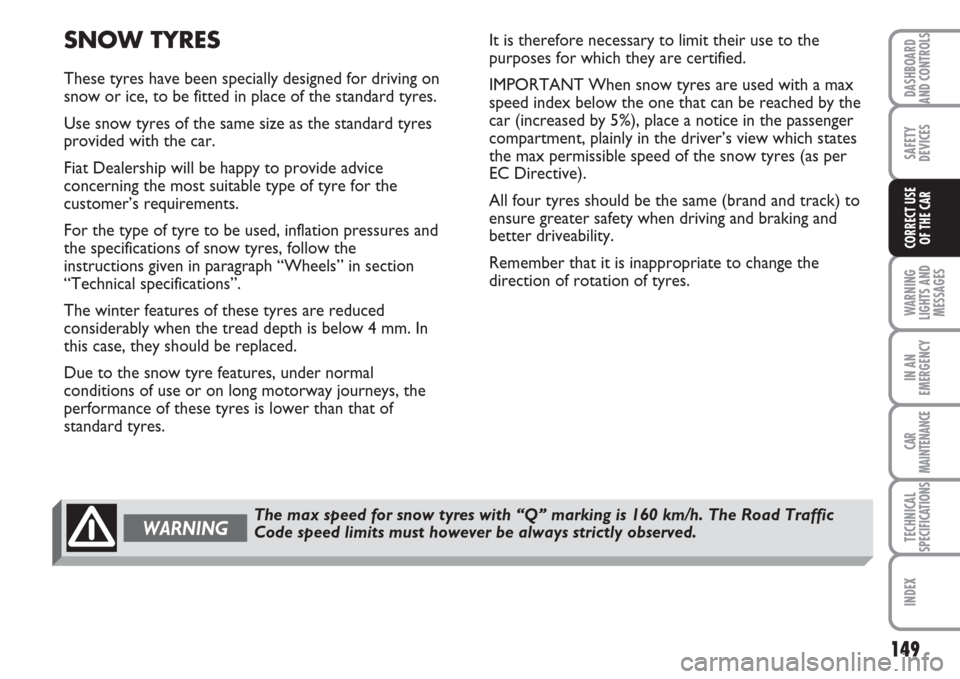
149
WARNING
LIGHTS AND
MESSAGES
IN AN
EMERGENCY
CAR
MAINTENANCE
TECHNICAL
SPECIFICATIONS
INDEX
DASHBOARD
AND CONTROLS
SAFETY
DEVICES
CORRECT USE
OF THE CAR
SNOW TYRES
These tyres have been specially designed for driving on
snow or ice, to be fitted in place of the standard tyres.
Use snow tyres of the same size as the standard tyres
provided with the car.
Fiat Dealership will be happy to provide advice
concerning the most suitable type of tyre for the
customer’s requirements.
For the type of tyre to be used, inflation pressures and
the specifications of snow tyres, follow the
instructions given in paragraph “Wheels” in section
“Technical specifications”.
The winter features of these tyres are reduced
considerably when the tread depth is below 4 mm. In
this case, they should be replaced.
Due to the snow tyre features, under normal
conditions of use or on long motorway journeys, the
performance of these tyres is lower than that of
standard tyres.It is therefore necessary to limit their use to the
purposes for which they are certified.
IMPORTANT When snow tyres are used with a max
speed index below the one that can be reached by the
car (increased by 5%), place a notice in the passenger
compartment, plainly in the driver’s view which states
the max permissible speed of the snow tyres (as per
EC Directive).
All four tyres should be the same (brand and track) to
ensure greater safety when driving and braking and
better driveability.
Remember that it is inappropriate to change the
direction of rotation of tyres.
The max speed for snow tyres with “Q” marking is 160 km/h. The Road Traffic
Code speed limits must however be always strictly observed.WARNING
Page 151 of 266
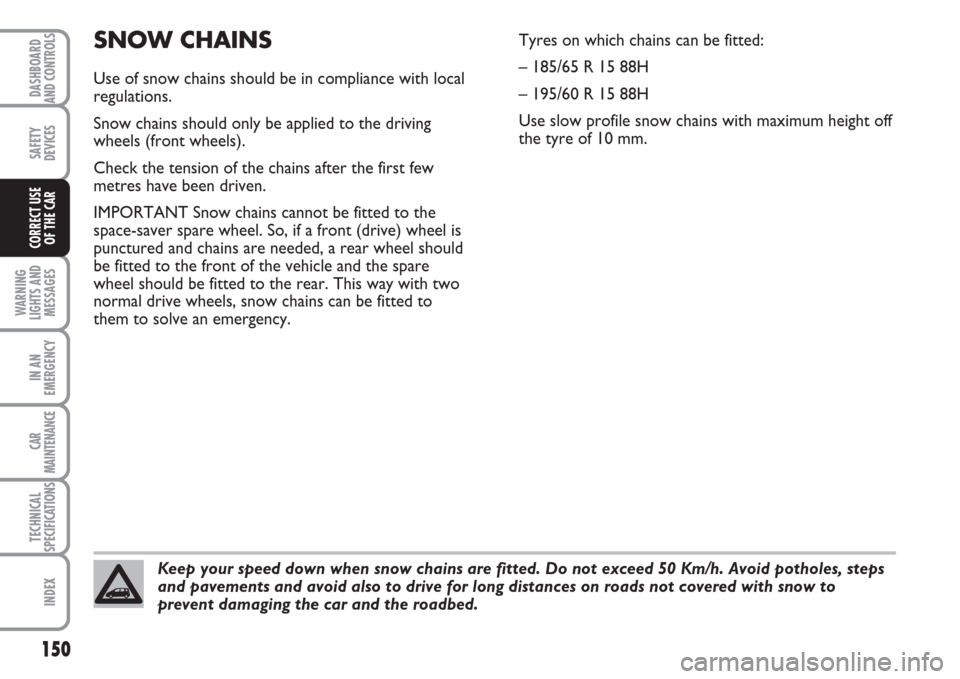
150
WARNING
LIGHTS AND
MESSAGES
IN AN
EMERGENCY
CAR
MAINTENANCE
TECHNICAL
SPECIFICATIONS
INDEX
DASHBOARD
AND CONTROLS
SAFETY
DEVICES
CORRECT USE
OF THE CAR
SNOW CHAINS
Use of snow chains should be in compliance with local
regulations.
Snow chains should only be applied to the driving
wheels (front wheels).
Check the tension of the chains after the first few
metres have been driven.
IMPORTANT Snow chains cannot be fitted to the
space-saver spare wheel. So, if a front (drive) wheel is
punctured and chains are needed, a rear wheel should
be fitted to the front of the vehicle and the spare
wheel should be fitted to the rear. This way with two
normal drive wheels, snow chains can be fitted to
them to solve an emergency.Tyres on which chains can be fitted:
– 185/65 R 15 88H
– 195/60 R 15 88H
Use slow profile snow chains with maximum height off
the tyre of 10 mm.
Keep your speed down when snow chains are fitted. Do not exceed 50 Km/h. Avoid potholes, steps
and pavements and avoid also to drive for long distances on roads not covered with snow to
prevent damaging the car and the roadbed.
Page 152 of 266
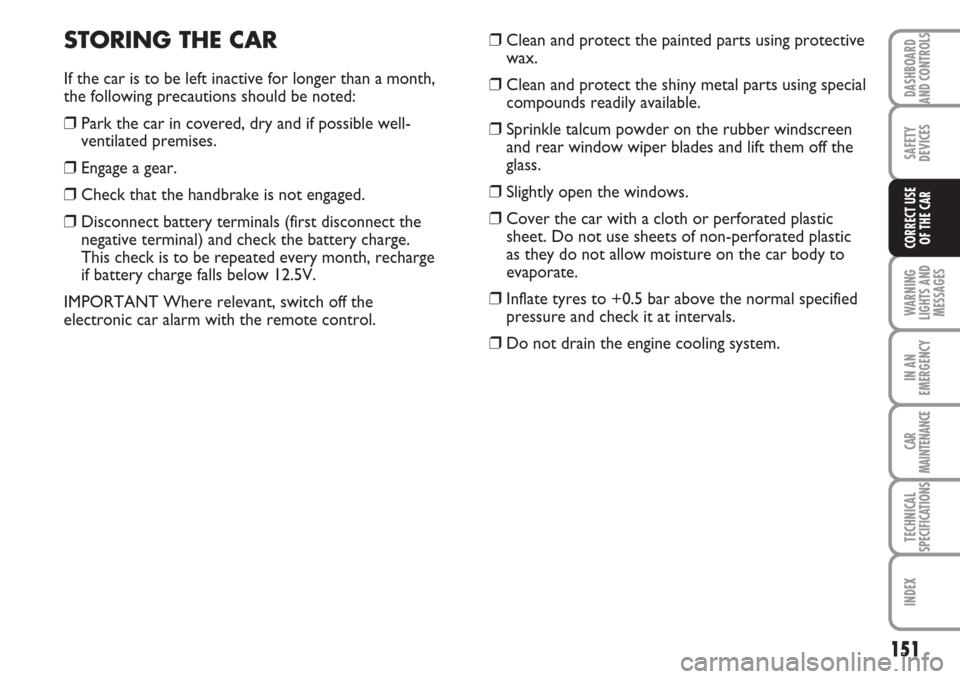
151
WARNING
LIGHTS AND
MESSAGES
IN AN
EMERGENCY
CAR
MAINTENANCE
TECHNICAL
SPECIFICATIONS
INDEX
DASHBOARD
AND CONTROLS
SAFETY
DEVICES
CORRECT USE
OF THE CAR
STORING THE CAR
If the car is to be left inactive for longer than a month,
the following precautions should be noted:
❒Park the car in covered, dry and if possible well-
ventilated premises.
❒Engage a gear.
❒Check that the handbrake is not engaged.
❒Disconnect battery terminals (first disconnect the
negative terminal) and check the battery charge.
This check is to be repeated every month, recharge
if battery charge falls below 12.5V.
IMPORTANT Where relevant, switch off the
electronic car alarm with the remote control.❒Clean and protect the painted parts using protective
wax.
❒Clean and protect the shiny metal parts using special
compounds readily available.
❒Sprinkle talcum powder on the rubber windscreen
and rear window wiper blades and lift them off the
glass.
❒Slightly open the windows.
❒Cover the car with a cloth or perforated plastic
sheet. Do not use sheets of non-perforated plastic
as they do not allow moisture on the car body to
evaporate.
❒Inflate tyres to +0.5 bar above the normal specified
pressure and check it at intervals.
❒Do not drain the engine cooling system.
Page 165 of 266
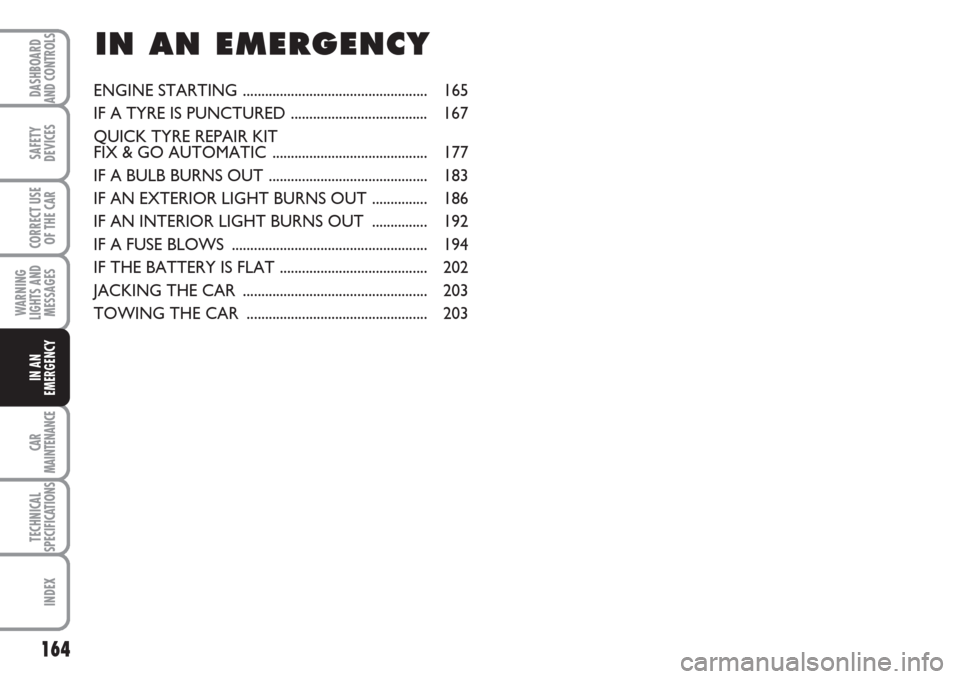
164
SAFETY
DEVICES
CORRECT USE
OF THE CAR
WARNING
LIGHTS AND
MESSAGES
CAR
MAINTENANCE
TECHNICAL
SPECIFICATIONS
INDEX
DASHBOARD
AND CONTROLS
IN AN
EMERGENCY
II I
N N
A A
N N
E E
M M
E E
R R
G G
E E
N N
C C
Y Y
ENGINE STARTING .................................................. 165
IF A TYRE IS PUNCTURED ..................................... 167
QUICK TYRE REPAIR KIT
FIX & GO AUTOMATIC .......................................... 177
IF A BULB BURNS OUT ........................................... 183
IF AN EXTERIOR LIGHT BURNS OUT ............... 186
IF AN INTERIOR LIGHT BURNS OUT ............... 192
IF A FUSE BLOWS ..................................................... 194
IF THE BATTERY IS FLAT ........................................ 202
JACKING THE CAR .................................................. 203
TOWING THE CAR ................................................. 203